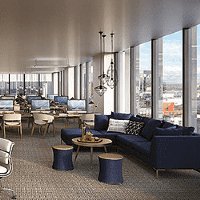We saw the inception of defurbishments in the Shoreditch/ Old Street market, however, defurbishments are now becoming an increasingly important part of the regional office market. So what exactly defines a defurbishment?
A defurbishment is where office space has undergone a transformation based on the exposure and enhancement of the existing building's features, including exposed brickwork and high, open ceilings. This steps away from the traditional layout and provides a space which is more collaborative, creative and flexible.
From Savills 2016 What Workers Want survey, workers were most dissatisfied with lighting in the office. By stripping away the suspended ceilings and adopting exposed ceilings, this provides more natural light and has proved particularly effective on lower ground floor office space.
Wellness is becoming an increasingly important factor in the design and delivery of office space. We are seeing rising demand for break out areas in offices, which provide workers with increasingly flexible meeting space, creating a more informal environment. Developers are now increasingly listening to workers' demands and are designing their schemes around co-working space.
One such building which provides occupiers in this sector with ‘defurbished’ office space is 101 St Mary Street, Cardiff. The owners of this building have successfully created the type of office space provided in such locations as Shoreditch, London, where a number of the tech and creative sectors are clustering.
In Manchester, we have seen a number of defurbishments situated towards the fringe locations, particularly the Northern Quarter, where a number of tech and creative occupiers are located. Neo, Manchester, (pictured below), has undergone a comprehensive refurbishment to provide 52,000 sq ft of collaborative, Grade A space.

